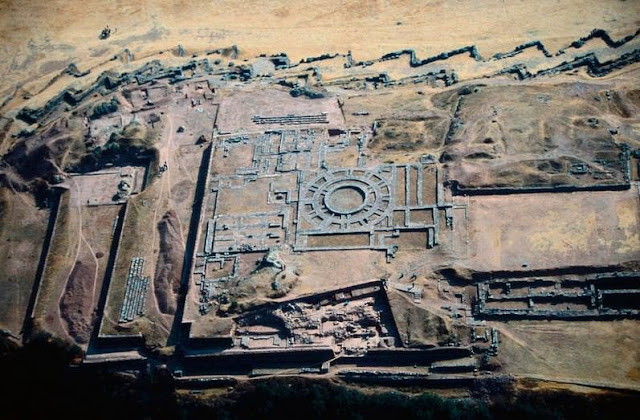Source Video:
https://www.youtube.com/watch?v=E23s8MmSjuQ
Kailashnath Temple, also Kailash or Kailāsa or
Kailasanath Temple, is a famous temple, one of the 34 monasteries and
temples known collectively as the Ellora Caves, extending over more than 2 km,
that were dug side by side in the wall of a high basalt cliff in the complex
located at Ellora, Maharashtra, India. Of these, the Kailasa (cave 16) is a
remarkable example of Dravidian architecture on account of its striking
proportion; elaborate workmanship architectural content and sculptural
ornamentation of rock-cut architecture. It is designed to recall Mount Kailash,
the abode of Lord Shiva. It is a megalith carved out of one single rock
and is claimed to have been built in the 8th century by the Rashtrakuta king
Krishna I. However, rock cannot be carbon dated so personnally, I believe this
wonder to be much older than it is claimed to be.
It is estimated that about
400,000 tons of rocks were scooped out over hundreds of years to construct this
monolithic structure.
All the carvings are done in more
than one level. A two-storeyed gateway opens to reveal a U-shaped courtyard.
The courtyard is edged by a columned arcade three stories high. The arcades are
punctuated by huge sculpted panels, and alcoves containing enormous sculptures
of a variety of deities. Originally flying bridges of stone connected these
galleries to central temple structures, but these have fallen.
Within the courtyard are two
structures. As is traditional in Shiva temples, an image of the sacred bull
Nandi fronts the central temple housing the lingam. In Cave 16, the Nandi Mandap
and main Shiva temple are each about 7 metres high, and built on two storeys.
The lower stories of the Nandi Mandap are both solid structures, decorated with
elaborate illustrative carvings. The base of the temple has been carved to
suggest that elephants are holding the structure aloft.
A rock bridge connects the Nandi
Mandap to the porch of the temple. The temple itself is a tall pyramidic
structure reminiscent of a South Indian temple. The shrine – complete with
pillars, windows, inner and outer rooms, gathering halls, and an enormous stone
lingam at its heart – is carved with niches, plasters, windows as well as
images of deities, mithunas (erotic male and female figures) and other
figures. Most of the deities at the left of the entrance are Shaivaite
(followers of Lord Shiva) while on the right hand side the deities are
Vaishnavaites (followers of Lord Vishnu).
There are two Dhwajasthambha
(pillars with the flagstaff) in the courtyard. The grand sculpture of Ravana
attempting to lift Mount Kailasa, the abode of Lord Shiva, with his --full
might is a landmark in Indian art.
---------------------------------------------
Ajanta Caves, India
The Ajanta Caves in
Aurangabad district of Maharashtra, India are about 300 rock-cut Buddhist cave
monuments which claimed to date from the 2nd century BCE to about 480 or 650
CE. The caves include paintings and sculptures described by the government
Archaeological Survey of India as "the finest surviving examples of Indian
art, particularly painting", which are masterpieces of Buddhist religious
art, with figures of the Buddha and depictions of the Jataka tales. The caves
were built in two phases starting around the 2nd century BCE, with the second
group of caves built around 400–650 CE according to older accounts, or all in a
brief period between 460 to 480 according to the recent proposals of Walter M.
Spink. The site is a protected monument in the care of the Archaeological
Survey of India, and since 1983, the Ajanta Caves have been a UNESCO World
Heritage Site.
The caves are located in the
Indian state of Maharashtra, near Jalgaon and just outside the village of Ajinṭhā. They are 100 kilometres (62 miles) from the
Ellora Caves, which contain Hindu and Jain temples as well as Buddhist caves,
the last dating from a period similar to Ajanta. The Ajanta caves are cut into
the side of a cliff that is on the south side of a U-shaped gorge on the small
river Waghora (or Wagura), and although they are now along and above a modern
pathway running across the cliff they were originally reached by individual
stairs or ladders from the side of the river 35 to 110 feet below.
The area was previously heavily
forested, and after the site ceased to be used the caves were covered by jungle
until accidentally rediscovered in 1819 by a British officer on a hunting
party. They are Buddhist monastic buildings, apparently representing a number
of distinct "monasteries" or colleges. The caves are numbered 1 to 28
according to their place along the path, beginning at the entrance. Several are
unfinished and some barely begun and others are small shrines, included in the
traditional numbering as e.g. "9A"; "Cave 15A" was still
hidden under rubble when the numbering was done. Further round the gorge are a
number of waterfalls, which when the river is high are audible from outside the
caves.
The caves form the largest corpus
of early Indian wall-painting; indeed other survivals from the area of modern
India are very few indeed, though they are related to 5th-century paintings at
Sigiriya in Sri Lanka. The elaborate architectural carving in many caves is
also very rare, and the style of the many figure sculptures is a highly local
one, found only at a couple of nearby contemporary sites, although the Ajanta
tradition can be related to the later Hindu Ellora Caves and other sites.







